Leadership in Nursing Assignment PDF
VerifiedAdded on 2021/05/31
|12
|3501
|285
AI Summary
Contribute Materials
Your contribution can guide someone’s learning journey. Share your
documents today.
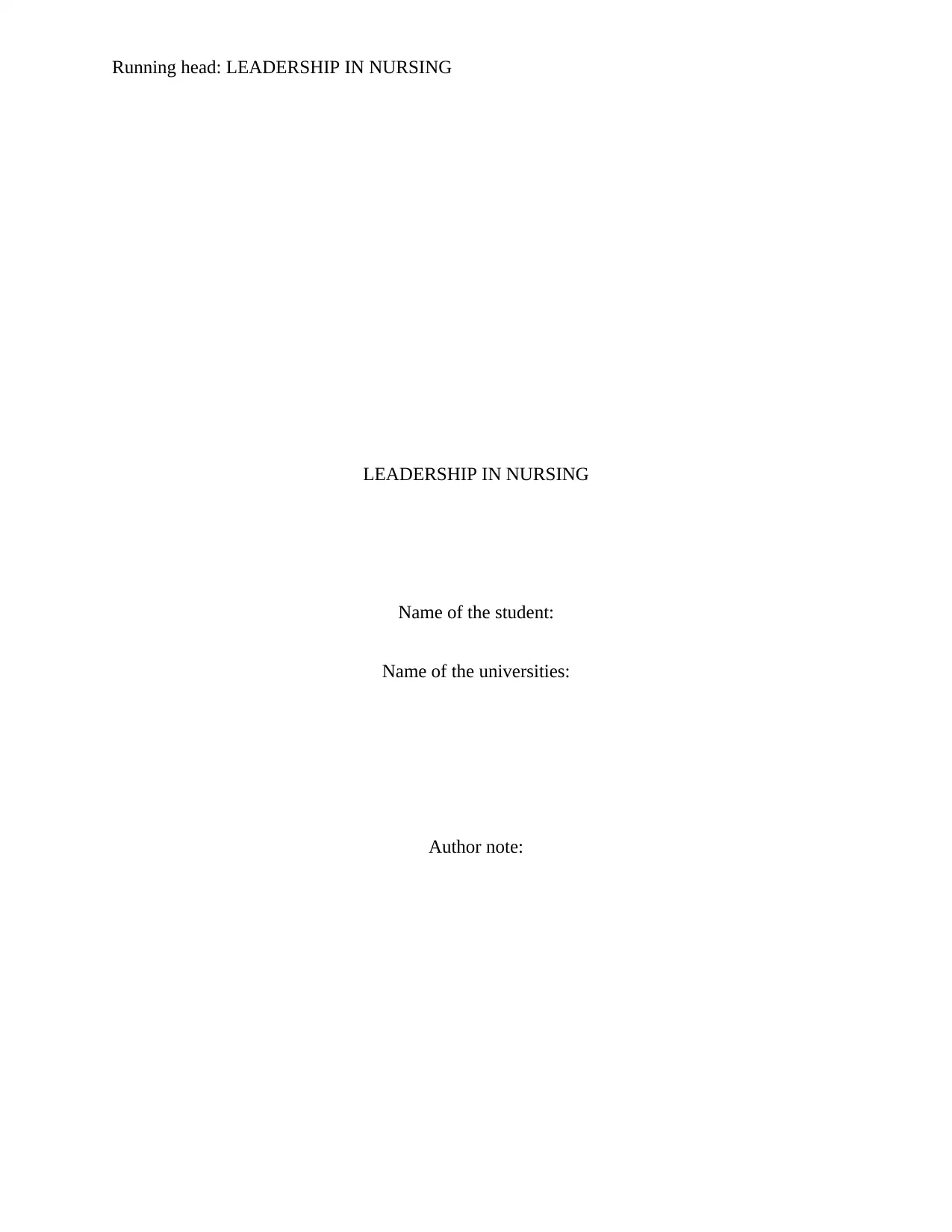
Running head: LEADERSHIP IN NURSING
LEADERSHIP IN NURSING
Name of the student:
Name of the universities:
Author note:
LEADERSHIP IN NURSING
Name of the student:
Name of the universities:
Author note:
Secure Best Marks with AI Grader
Need help grading? Try our AI Grader for instant feedback on your assignments.
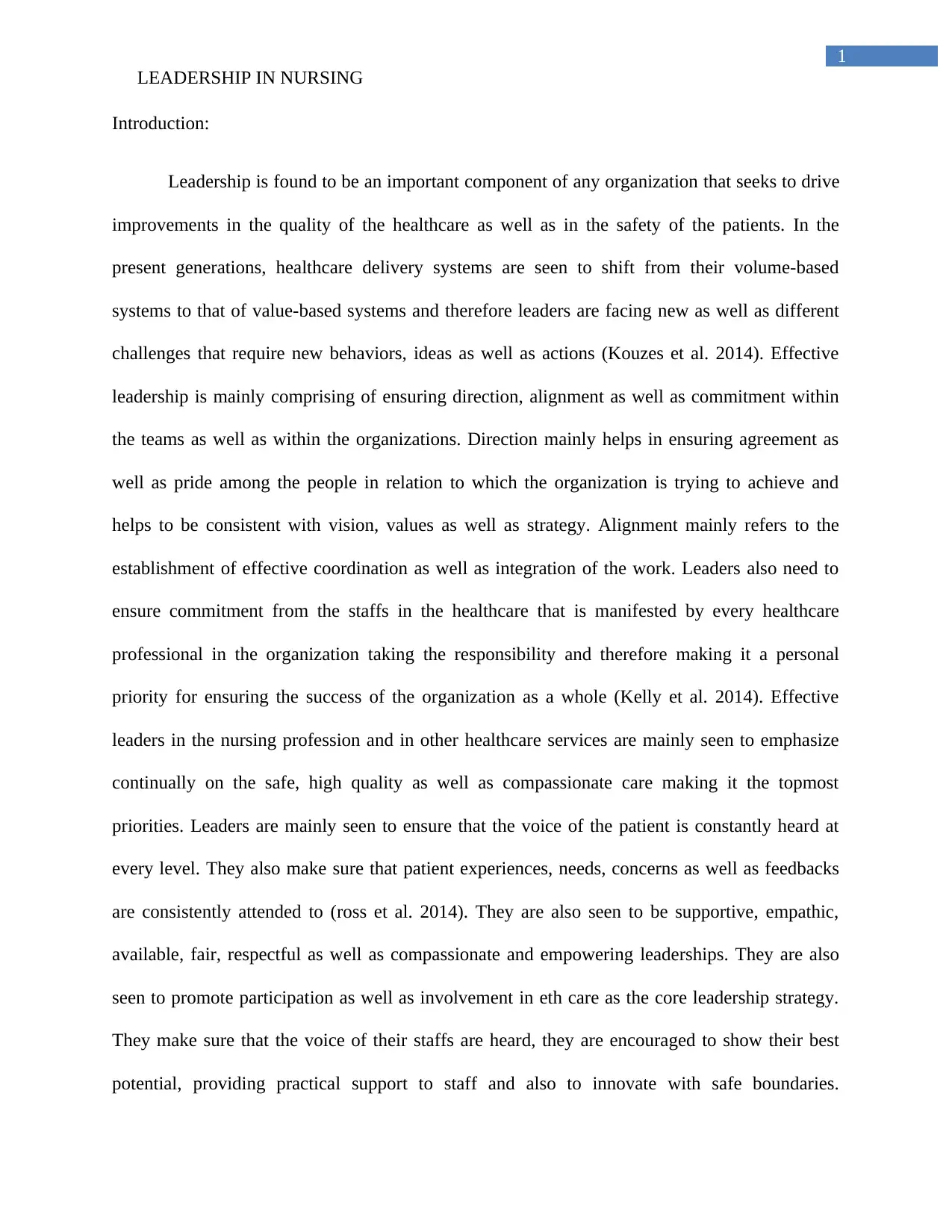
1
LEADERSHIP IN NURSING
Introduction:
Leadership is found to be an important component of any organization that seeks to drive
improvements in the quality of the healthcare as well as in the safety of the patients. In the
present generations, healthcare delivery systems are seen to shift from their volume-based
systems to that of value-based systems and therefore leaders are facing new as well as different
challenges that require new behaviors, ideas as well as actions (Kouzes et al. 2014). Effective
leadership is mainly comprising of ensuring direction, alignment as well as commitment within
the teams as well as within the organizations. Direction mainly helps in ensuring agreement as
well as pride among the people in relation to which the organization is trying to achieve and
helps to be consistent with vision, values as well as strategy. Alignment mainly refers to the
establishment of effective coordination as well as integration of the work. Leaders also need to
ensure commitment from the staffs in the healthcare that is manifested by every healthcare
professional in the organization taking the responsibility and therefore making it a personal
priority for ensuring the success of the organization as a whole (Kelly et al. 2014). Effective
leaders in the nursing profession and in other healthcare services are mainly seen to emphasize
continually on the safe, high quality as well as compassionate care making it the topmost
priorities. Leaders are mainly seen to ensure that the voice of the patient is constantly heard at
every level. They also make sure that patient experiences, needs, concerns as well as feedbacks
are consistently attended to (ross et al. 2014). They are also seen to be supportive, empathic,
available, fair, respectful as well as compassionate and empowering leaderships. They are also
seen to promote participation as well as involvement in eth care as the core leadership strategy.
They make sure that the voice of their staffs are heard, they are encouraged to show their best
potential, providing practical support to staff and also to innovate with safe boundaries.
LEADERSHIP IN NURSING
Introduction:
Leadership is found to be an important component of any organization that seeks to drive
improvements in the quality of the healthcare as well as in the safety of the patients. In the
present generations, healthcare delivery systems are seen to shift from their volume-based
systems to that of value-based systems and therefore leaders are facing new as well as different
challenges that require new behaviors, ideas as well as actions (Kouzes et al. 2014). Effective
leadership is mainly comprising of ensuring direction, alignment as well as commitment within
the teams as well as within the organizations. Direction mainly helps in ensuring agreement as
well as pride among the people in relation to which the organization is trying to achieve and
helps to be consistent with vision, values as well as strategy. Alignment mainly refers to the
establishment of effective coordination as well as integration of the work. Leaders also need to
ensure commitment from the staffs in the healthcare that is manifested by every healthcare
professional in the organization taking the responsibility and therefore making it a personal
priority for ensuring the success of the organization as a whole (Kelly et al. 2014). Effective
leaders in the nursing profession and in other healthcare services are mainly seen to emphasize
continually on the safe, high quality as well as compassionate care making it the topmost
priorities. Leaders are mainly seen to ensure that the voice of the patient is constantly heard at
every level. They also make sure that patient experiences, needs, concerns as well as feedbacks
are consistently attended to (ross et al. 2014). They are also seen to be supportive, empathic,
available, fair, respectful as well as compassionate and empowering leaderships. They are also
seen to promote participation as well as involvement in eth care as the core leadership strategy.
They make sure that the voice of their staffs are heard, they are encouraged to show their best
potential, providing practical support to staff and also to innovate with safe boundaries.

2
LEADERSHIP IN NURSING
Therefore, leaders play an important role in the nursing profession taking the responsibility of
not only teams serving the patients but also the responsibility of the patients’ welfare (Kouzes et
al. 2017). This assignment will thereby show how the important five exemplary leadership
practices could be developed along with the ten leadership commitments so that the leadership
trait exhibited helps the team members of nursing to exhibit their best skills and help in meeting
the organizational goals and missions.
Example of leadership that I have experienced in myself:
During the times of clinical placement, I got the opportunity to become a leader of about
10 fresher nursing professionals who were very new to the healthcare system and had no prior
experiences beforehand. Although they had good theoretical knowledge, they did not have the
proper experience to attend patients and care for them effectively. However, I was also new to
the role of leadership and could not understand how to initiate the system of leading. I assigned
them with tasks and asked them to start attending to their roles. They seemed to be confused but
could not state their concerns to me. I developed the idea that though gradual experiences, they
would be able to learn. When one of them came back with a complaint, that she is unable to
understand how to approach with the tasks. I blamed her stating that she had not completed her
academics properly and so she is facing issues. When a crisis arrived as more than ten children
had been admitted for cholera from a school, I grew nervous and could not understand how to
tackle so many children at the same time. Seeing me nervous, the team members also got scared
and nervous and one of them was on the verge of crying as she got scared of failing to face the
children. I could not help them gather courage at that instance and my mentor in turn handled it
effectively. I have also failed to provide any innovative ways of development and therefore the
team members got easily burned out. I have always tried playing safe in my leadership roles and
LEADERSHIP IN NURSING
Therefore, leaders play an important role in the nursing profession taking the responsibility of
not only teams serving the patients but also the responsibility of the patients’ welfare (Kouzes et
al. 2017). This assignment will thereby show how the important five exemplary leadership
practices could be developed along with the ten leadership commitments so that the leadership
trait exhibited helps the team members of nursing to exhibit their best skills and help in meeting
the organizational goals and missions.
Example of leadership that I have experienced in myself:
During the times of clinical placement, I got the opportunity to become a leader of about
10 fresher nursing professionals who were very new to the healthcare system and had no prior
experiences beforehand. Although they had good theoretical knowledge, they did not have the
proper experience to attend patients and care for them effectively. However, I was also new to
the role of leadership and could not understand how to initiate the system of leading. I assigned
them with tasks and asked them to start attending to their roles. They seemed to be confused but
could not state their concerns to me. I developed the idea that though gradual experiences, they
would be able to learn. When one of them came back with a complaint, that she is unable to
understand how to approach with the tasks. I blamed her stating that she had not completed her
academics properly and so she is facing issues. When a crisis arrived as more than ten children
had been admitted for cholera from a school, I grew nervous and could not understand how to
tackle so many children at the same time. Seeing me nervous, the team members also got scared
and nervous and one of them was on the verge of crying as she got scared of failing to face the
children. I could not help them gather courage at that instance and my mentor in turn handled it
effectively. I have also failed to provide any innovative ways of development and therefore the
team members got easily burned out. I have always tried playing safe in my leadership roles and
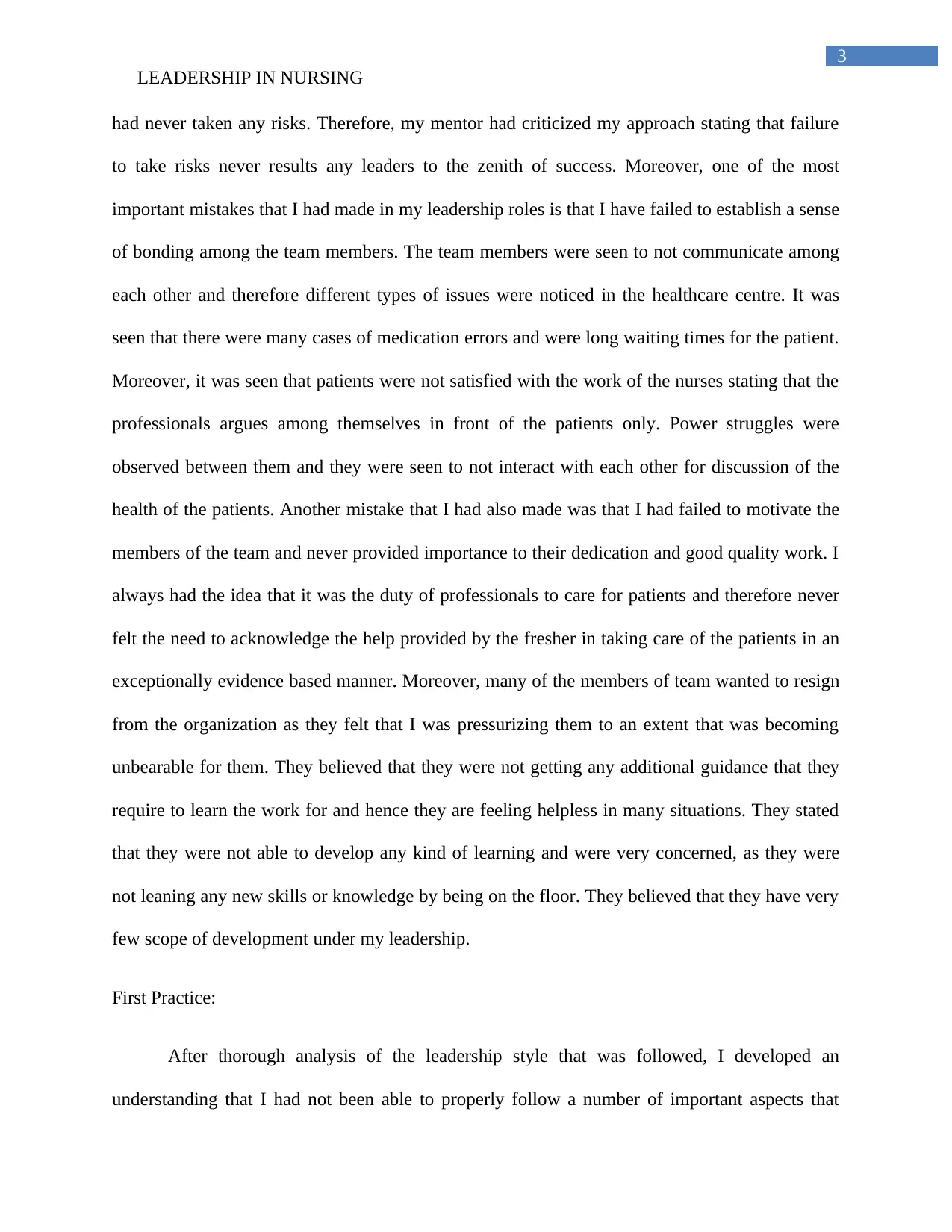
3
LEADERSHIP IN NURSING
had never taken any risks. Therefore, my mentor had criticized my approach stating that failure
to take risks never results any leaders to the zenith of success. Moreover, one of the most
important mistakes that I had made in my leadership roles is that I have failed to establish a sense
of bonding among the team members. The team members were seen to not communicate among
each other and therefore different types of issues were noticed in the healthcare centre. It was
seen that there were many cases of medication errors and were long waiting times for the patient.
Moreover, it was seen that patients were not satisfied with the work of the nurses stating that the
professionals argues among themselves in front of the patients only. Power struggles were
observed between them and they were seen to not interact with each other for discussion of the
health of the patients. Another mistake that I had also made was that I had failed to motivate the
members of the team and never provided importance to their dedication and good quality work. I
always had the idea that it was the duty of professionals to care for patients and therefore never
felt the need to acknowledge the help provided by the fresher in taking care of the patients in an
exceptionally evidence based manner. Moreover, many of the members of team wanted to resign
from the organization as they felt that I was pressurizing them to an extent that was becoming
unbearable for them. They believed that they were not getting any additional guidance that they
require to learn the work for and hence they are feeling helpless in many situations. They stated
that they were not able to develop any kind of learning and were very concerned, as they were
not leaning any new skills or knowledge by being on the floor. They believed that they have very
few scope of development under my leadership.
First Practice:
After thorough analysis of the leadership style that was followed, I developed an
understanding that I had not been able to properly follow a number of important aspects that
LEADERSHIP IN NURSING
had never taken any risks. Therefore, my mentor had criticized my approach stating that failure
to take risks never results any leaders to the zenith of success. Moreover, one of the most
important mistakes that I had made in my leadership roles is that I have failed to establish a sense
of bonding among the team members. The team members were seen to not communicate among
each other and therefore different types of issues were noticed in the healthcare centre. It was
seen that there were many cases of medication errors and were long waiting times for the patient.
Moreover, it was seen that patients were not satisfied with the work of the nurses stating that the
professionals argues among themselves in front of the patients only. Power struggles were
observed between them and they were seen to not interact with each other for discussion of the
health of the patients. Another mistake that I had also made was that I had failed to motivate the
members of the team and never provided importance to their dedication and good quality work. I
always had the idea that it was the duty of professionals to care for patients and therefore never
felt the need to acknowledge the help provided by the fresher in taking care of the patients in an
exceptionally evidence based manner. Moreover, many of the members of team wanted to resign
from the organization as they felt that I was pressurizing them to an extent that was becoming
unbearable for them. They believed that they were not getting any additional guidance that they
require to learn the work for and hence they are feeling helpless in many situations. They stated
that they were not able to develop any kind of learning and were very concerned, as they were
not leaning any new skills or knowledge by being on the floor. They believed that they have very
few scope of development under my leadership.
First Practice:
After thorough analysis of the leadership style that was followed, I developed an
understanding that I had not been able to properly follow a number of important aspects that
Secure Best Marks with AI Grader
Need help grading? Try our AI Grader for instant feedback on your assignments.
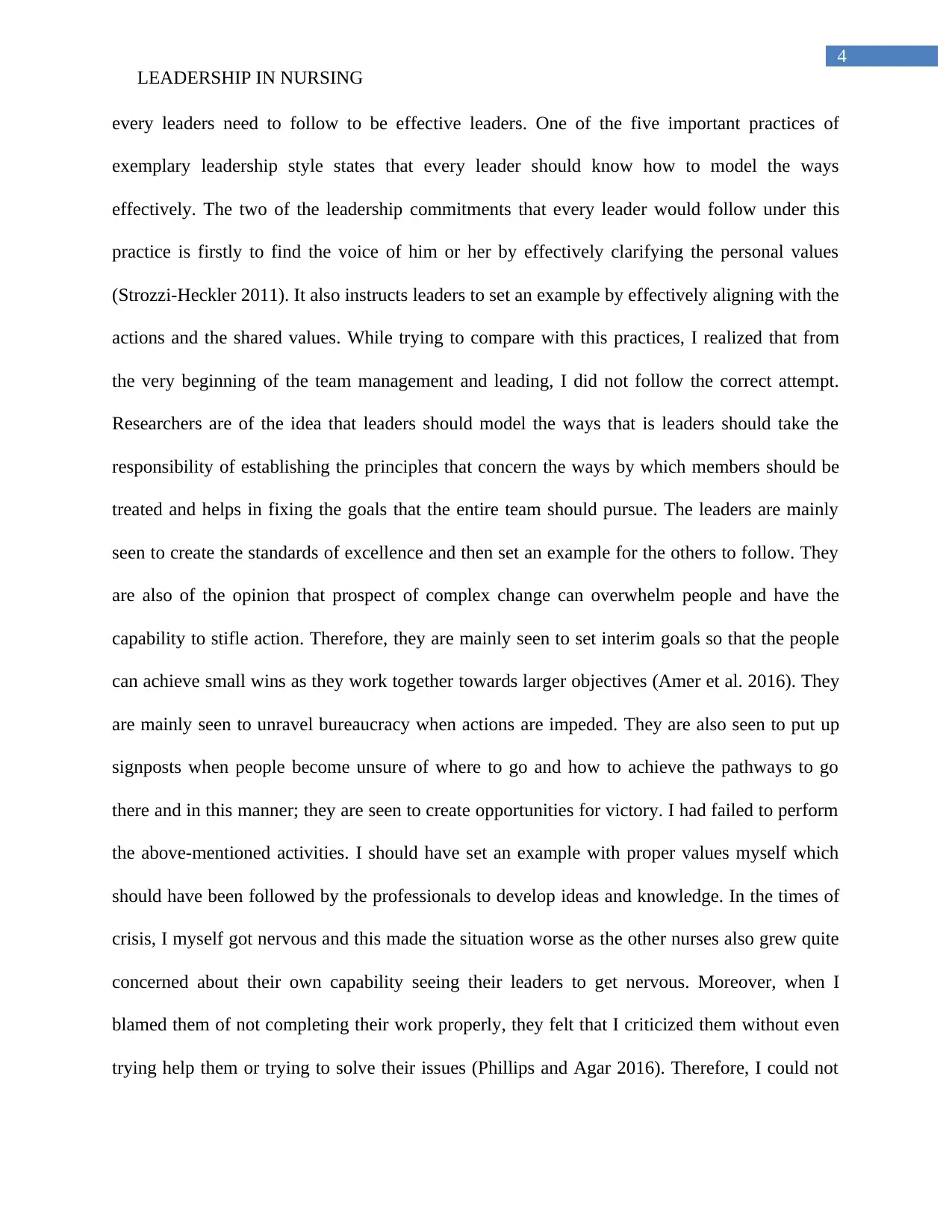
4
LEADERSHIP IN NURSING
every leaders need to follow to be effective leaders. One of the five important practices of
exemplary leadership style states that every leader should know how to model the ways
effectively. The two of the leadership commitments that every leader would follow under this
practice is firstly to find the voice of him or her by effectively clarifying the personal values
(Strozzi-Heckler 2011). It also instructs leaders to set an example by effectively aligning with the
actions and the shared values. While trying to compare with this practices, I realized that from
the very beginning of the team management and leading, I did not follow the correct attempt.
Researchers are of the idea that leaders should model the ways that is leaders should take the
responsibility of establishing the principles that concern the ways by which members should be
treated and helps in fixing the goals that the entire team should pursue. The leaders are mainly
seen to create the standards of excellence and then set an example for the others to follow. They
are also of the opinion that prospect of complex change can overwhelm people and have the
capability to stifle action. Therefore, they are mainly seen to set interim goals so that the people
can achieve small wins as they work together towards larger objectives (Amer et al. 2016). They
are mainly seen to unravel bureaucracy when actions are impeded. They are also seen to put up
signposts when people become unsure of where to go and how to achieve the pathways to go
there and in this manner; they are seen to create opportunities for victory. I had failed to perform
the above-mentioned activities. I should have set an example with proper values myself which
should have been followed by the professionals to develop ideas and knowledge. In the times of
crisis, I myself got nervous and this made the situation worse as the other nurses also grew quite
concerned about their own capability seeing their leaders to get nervous. Moreover, when I
blamed them of not completing their work properly, they felt that I criticized them without even
trying help them or trying to solve their issues (Phillips and Agar 2016). Therefore, I could not
LEADERSHIP IN NURSING
every leaders need to follow to be effective leaders. One of the five important practices of
exemplary leadership style states that every leader should know how to model the ways
effectively. The two of the leadership commitments that every leader would follow under this
practice is firstly to find the voice of him or her by effectively clarifying the personal values
(Strozzi-Heckler 2011). It also instructs leaders to set an example by effectively aligning with the
actions and the shared values. While trying to compare with this practices, I realized that from
the very beginning of the team management and leading, I did not follow the correct attempt.
Researchers are of the idea that leaders should model the ways that is leaders should take the
responsibility of establishing the principles that concern the ways by which members should be
treated and helps in fixing the goals that the entire team should pursue. The leaders are mainly
seen to create the standards of excellence and then set an example for the others to follow. They
are also of the opinion that prospect of complex change can overwhelm people and have the
capability to stifle action. Therefore, they are mainly seen to set interim goals so that the people
can achieve small wins as they work together towards larger objectives (Amer et al. 2016). They
are mainly seen to unravel bureaucracy when actions are impeded. They are also seen to put up
signposts when people become unsure of where to go and how to achieve the pathways to go
there and in this manner; they are seen to create opportunities for victory. I had failed to perform
the above-mentioned activities. I should have set an example with proper values myself which
should have been followed by the professionals to develop ideas and knowledge. In the times of
crisis, I myself got nervous and this made the situation worse as the other nurses also grew quite
concerned about their own capability seeing their leaders to get nervous. Moreover, when I
blamed them of not completing their work properly, they felt that I criticized them without even
trying help them or trying to solve their issues (Phillips and Agar 2016). Therefore, I could not
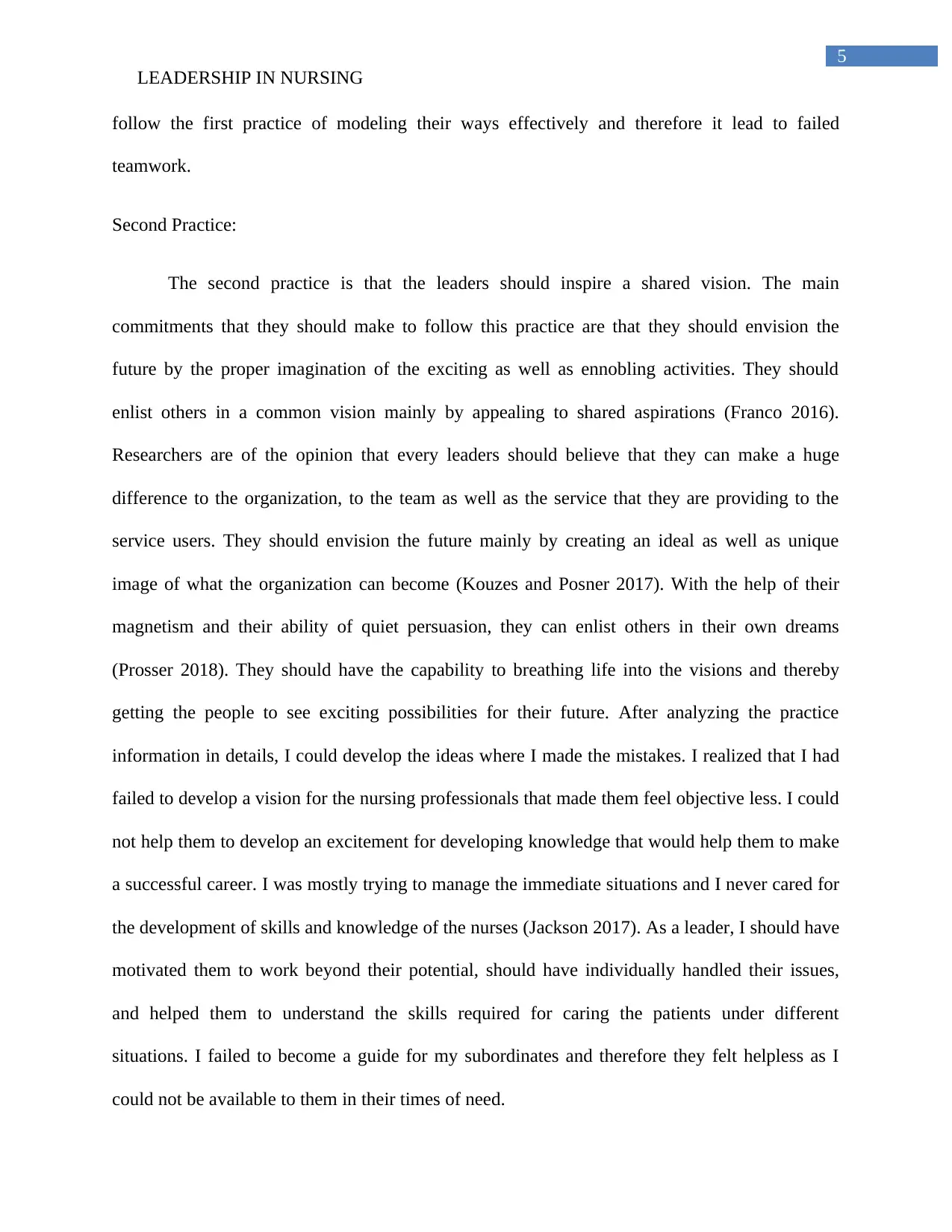
5
LEADERSHIP IN NURSING
follow the first practice of modeling their ways effectively and therefore it lead to failed
teamwork.
Second Practice:
The second practice is that the leaders should inspire a shared vision. The main
commitments that they should make to follow this practice are that they should envision the
future by the proper imagination of the exciting as well as ennobling activities. They should
enlist others in a common vision mainly by appealing to shared aspirations (Franco 2016).
Researchers are of the opinion that every leaders should believe that they can make a huge
difference to the organization, to the team as well as the service that they are providing to the
service users. They should envision the future mainly by creating an ideal as well as unique
image of what the organization can become (Kouzes and Posner 2017). With the help of their
magnetism and their ability of quiet persuasion, they can enlist others in their own dreams
(Prosser 2018). They should have the capability to breathing life into the visions and thereby
getting the people to see exciting possibilities for their future. After analyzing the practice
information in details, I could develop the ideas where I made the mistakes. I realized that I had
failed to develop a vision for the nursing professionals that made them feel objective less. I could
not help them to develop an excitement for developing knowledge that would help them to make
a successful career. I was mostly trying to manage the immediate situations and I never cared for
the development of skills and knowledge of the nurses (Jackson 2017). As a leader, I should have
motivated them to work beyond their potential, should have individually handled their issues,
and helped them to understand the skills required for caring the patients under different
situations. I failed to become a guide for my subordinates and therefore they felt helpless as I
could not be available to them in their times of need.
LEADERSHIP IN NURSING
follow the first practice of modeling their ways effectively and therefore it lead to failed
teamwork.
Second Practice:
The second practice is that the leaders should inspire a shared vision. The main
commitments that they should make to follow this practice are that they should envision the
future by the proper imagination of the exciting as well as ennobling activities. They should
enlist others in a common vision mainly by appealing to shared aspirations (Franco 2016).
Researchers are of the opinion that every leaders should believe that they can make a huge
difference to the organization, to the team as well as the service that they are providing to the
service users. They should envision the future mainly by creating an ideal as well as unique
image of what the organization can become (Kouzes and Posner 2017). With the help of their
magnetism and their ability of quiet persuasion, they can enlist others in their own dreams
(Prosser 2018). They should have the capability to breathing life into the visions and thereby
getting the people to see exciting possibilities for their future. After analyzing the practice
information in details, I could develop the ideas where I made the mistakes. I realized that I had
failed to develop a vision for the nursing professionals that made them feel objective less. I could
not help them to develop an excitement for developing knowledge that would help them to make
a successful career. I was mostly trying to manage the immediate situations and I never cared for
the development of skills and knowledge of the nurses (Jackson 2017). As a leader, I should have
motivated them to work beyond their potential, should have individually handled their issues,
and helped them to understand the skills required for caring the patients under different
situations. I failed to become a guide for my subordinates and therefore they felt helpless as I
could not be available to them in their times of need.

6
LEADERSHIP IN NURSING
Third Practice:
The third practice is mainly challenging the process. The main commitments that should
be developed are that the leaders should search for the opportunities mainly by the seeking of the
innovative ways for change, growth and improvement (Ng and Foo 2016). They should also
experiment and thereby take risks by effectively generating small wins and learning from
different mistakes. Researchers are of the opinion that leaders should search for the opportunities
for changing the status quo. They should mainly look for the innovative ways for improvement
of the organization. They should mainly experiments and take up risks. Such rich taking may
involve different types of mistakes as well as failures (Priest and Gass 2017). These should not
demotivate the leaders and they should accept the inevitable disappointments as well as the
learning opportunities. One of the best ways of dealing with different types of potential risks as
well as the failures of experimentation is the proper approaching of the changes through the
incremental steps as well as the small wins (McAuley 2016). When I analyzed the situation, I
realized that i had also failed to meet up these criteria. I realized that I had always tried to be safe
with my every approach and never adopted anything that would include any risks. I always tried
to look for bigger goals to achieve and therefore never considered on the small wins that the
teams were making. I should not have scared for making mistakes and should have take risks that
might have resulted in bringing out some of the best ways of healthcare activities (Miller 2016).
These activities could have helped me in gaining the cope to learn from my mistakes and to
establish innovative ways by which I could have challenged the status quo and developed
innovative ways of handling the various issues that arose and manage them effectively.
LEADERSHIP IN NURSING
Third Practice:
The third practice is mainly challenging the process. The main commitments that should
be developed are that the leaders should search for the opportunities mainly by the seeking of the
innovative ways for change, growth and improvement (Ng and Foo 2016). They should also
experiment and thereby take risks by effectively generating small wins and learning from
different mistakes. Researchers are of the opinion that leaders should search for the opportunities
for changing the status quo. They should mainly look for the innovative ways for improvement
of the organization. They should mainly experiments and take up risks. Such rich taking may
involve different types of mistakes as well as failures (Priest and Gass 2017). These should not
demotivate the leaders and they should accept the inevitable disappointments as well as the
learning opportunities. One of the best ways of dealing with different types of potential risks as
well as the failures of experimentation is the proper approaching of the changes through the
incremental steps as well as the small wins (McAuley 2016). When I analyzed the situation, I
realized that i had also failed to meet up these criteria. I realized that I had always tried to be safe
with my every approach and never adopted anything that would include any risks. I always tried
to look for bigger goals to achieve and therefore never considered on the small wins that the
teams were making. I should not have scared for making mistakes and should have take risks that
might have resulted in bringing out some of the best ways of healthcare activities (Miller 2016).
These activities could have helped me in gaining the cope to learn from my mistakes and to
establish innovative ways by which I could have challenged the status quo and developed
innovative ways of handling the various issues that arose and manage them effectively.
Paraphrase This Document
Need a fresh take? Get an instant paraphrase of this document with our AI Paraphraser
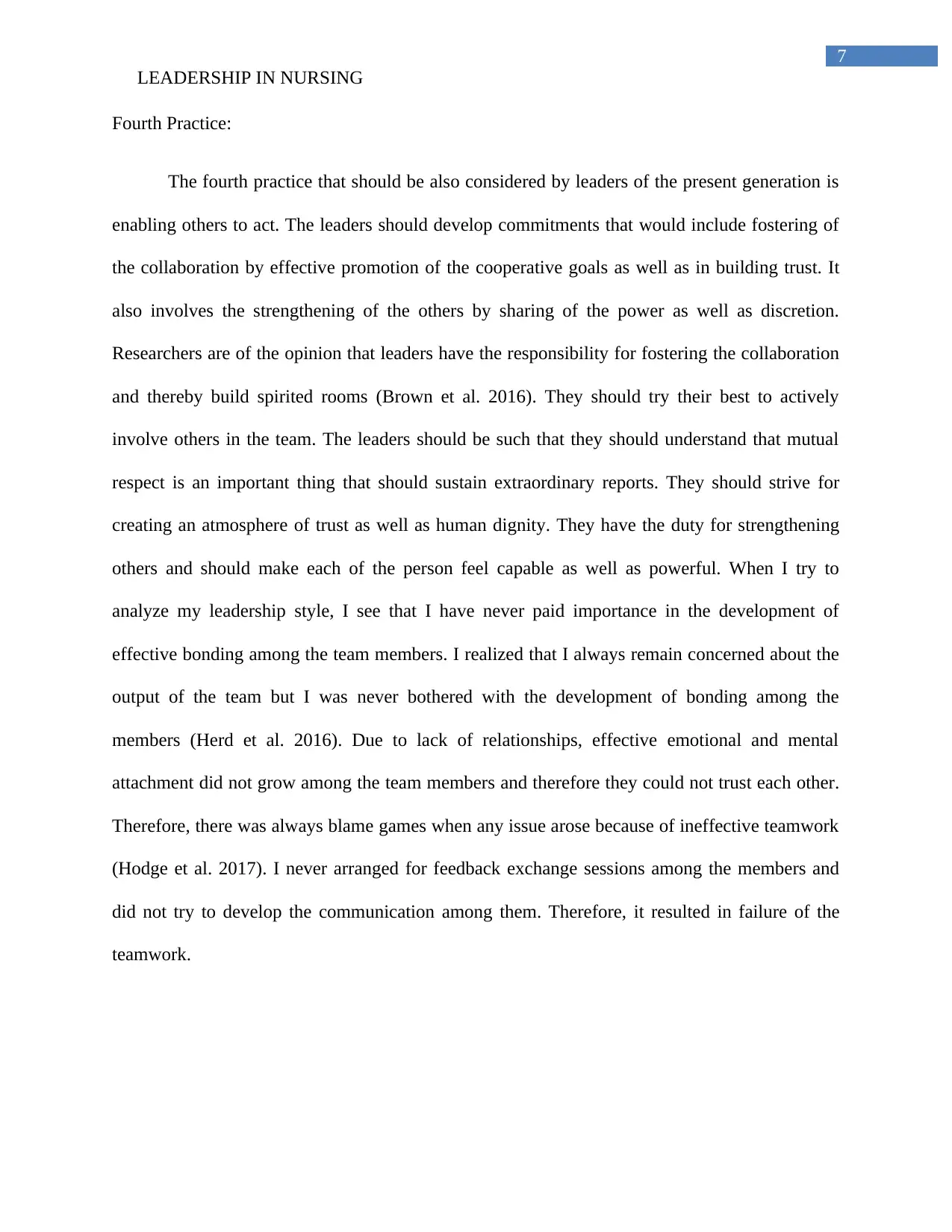
7
LEADERSHIP IN NURSING
Fourth Practice:
The fourth practice that should be also considered by leaders of the present generation is
enabling others to act. The leaders should develop commitments that would include fostering of
the collaboration by effective promotion of the cooperative goals as well as in building trust. It
also involves the strengthening of the others by sharing of the power as well as discretion.
Researchers are of the opinion that leaders have the responsibility for fostering the collaboration
and thereby build spirited rooms (Brown et al. 2016). They should try their best to actively
involve others in the team. The leaders should be such that they should understand that mutual
respect is an important thing that should sustain extraordinary reports. They should strive for
creating an atmosphere of trust as well as human dignity. They have the duty for strengthening
others and should make each of the person feel capable as well as powerful. When I try to
analyze my leadership style, I see that I have never paid importance in the development of
effective bonding among the team members. I realized that I always remain concerned about the
output of the team but I was never bothered with the development of bonding among the
members (Herd et al. 2016). Due to lack of relationships, effective emotional and mental
attachment did not grow among the team members and therefore they could not trust each other.
Therefore, there was always blame games when any issue arose because of ineffective teamwork
(Hodge et al. 2017). I never arranged for feedback exchange sessions among the members and
did not try to develop the communication among them. Therefore, it resulted in failure of the
teamwork.
LEADERSHIP IN NURSING
Fourth Practice:
The fourth practice that should be also considered by leaders of the present generation is
enabling others to act. The leaders should develop commitments that would include fostering of
the collaboration by effective promotion of the cooperative goals as well as in building trust. It
also involves the strengthening of the others by sharing of the power as well as discretion.
Researchers are of the opinion that leaders have the responsibility for fostering the collaboration
and thereby build spirited rooms (Brown et al. 2016). They should try their best to actively
involve others in the team. The leaders should be such that they should understand that mutual
respect is an important thing that should sustain extraordinary reports. They should strive for
creating an atmosphere of trust as well as human dignity. They have the duty for strengthening
others and should make each of the person feel capable as well as powerful. When I try to
analyze my leadership style, I see that I have never paid importance in the development of
effective bonding among the team members. I realized that I always remain concerned about the
output of the team but I was never bothered with the development of bonding among the
members (Herd et al. 2016). Due to lack of relationships, effective emotional and mental
attachment did not grow among the team members and therefore they could not trust each other.
Therefore, there was always blame games when any issue arose because of ineffective teamwork
(Hodge et al. 2017). I never arranged for feedback exchange sessions among the members and
did not try to develop the communication among them. Therefore, it resulted in failure of the
teamwork.
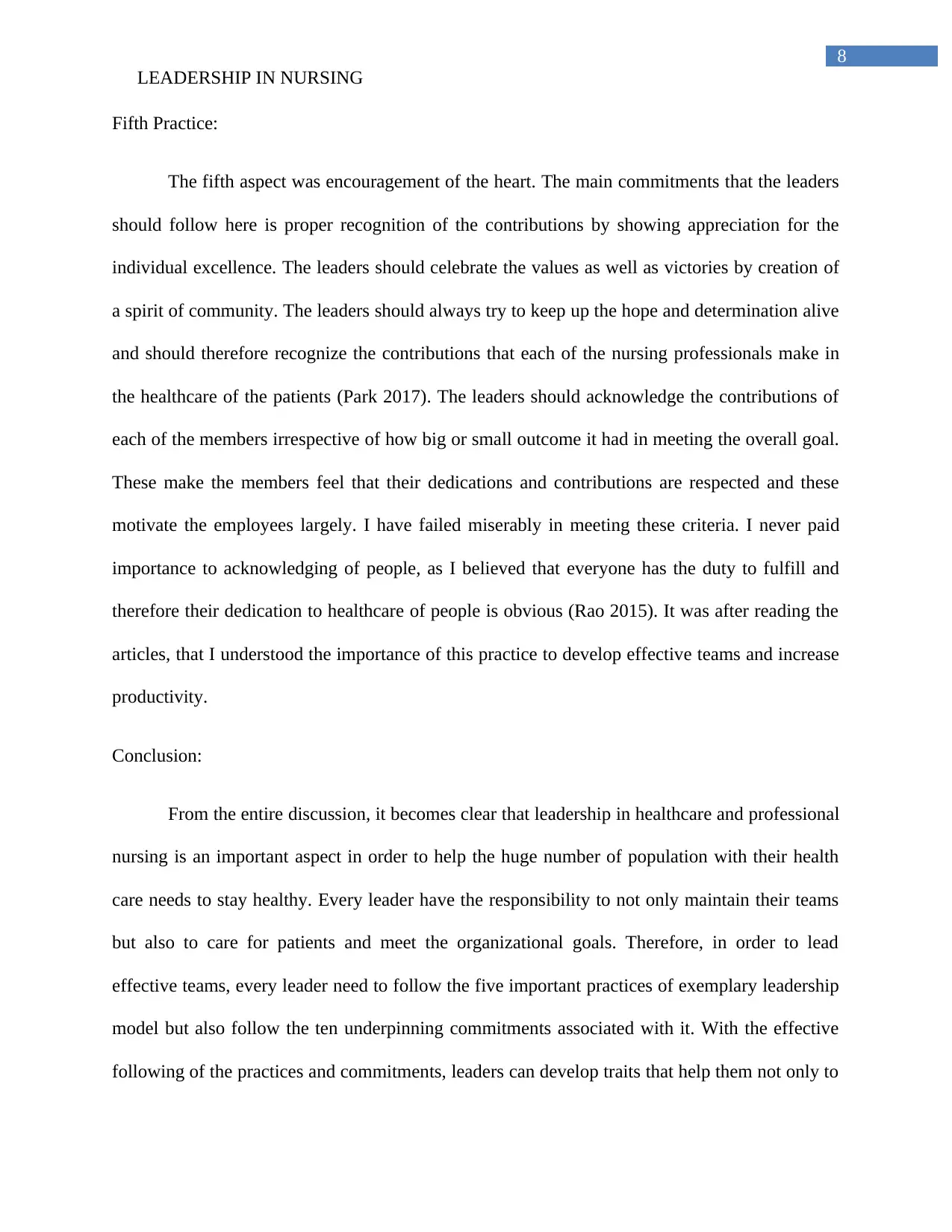
8
LEADERSHIP IN NURSING
Fifth Practice:
The fifth aspect was encouragement of the heart. The main commitments that the leaders
should follow here is proper recognition of the contributions by showing appreciation for the
individual excellence. The leaders should celebrate the values as well as victories by creation of
a spirit of community. The leaders should always try to keep up the hope and determination alive
and should therefore recognize the contributions that each of the nursing professionals make in
the healthcare of the patients (Park 2017). The leaders should acknowledge the contributions of
each of the members irrespective of how big or small outcome it had in meeting the overall goal.
These make the members feel that their dedications and contributions are respected and these
motivate the employees largely. I have failed miserably in meeting these criteria. I never paid
importance to acknowledging of people, as I believed that everyone has the duty to fulfill and
therefore their dedication to healthcare of people is obvious (Rao 2015). It was after reading the
articles, that I understood the importance of this practice to develop effective teams and increase
productivity.
Conclusion:
From the entire discussion, it becomes clear that leadership in healthcare and professional
nursing is an important aspect in order to help the huge number of population with their health
care needs to stay healthy. Every leader have the responsibility to not only maintain their teams
but also to care for patients and meet the organizational goals. Therefore, in order to lead
effective teams, every leader need to follow the five important practices of exemplary leadership
model but also follow the ten underpinning commitments associated with it. With the effective
following of the practices and commitments, leaders can develop traits that help them not only to
LEADERSHIP IN NURSING
Fifth Practice:
The fifth aspect was encouragement of the heart. The main commitments that the leaders
should follow here is proper recognition of the contributions by showing appreciation for the
individual excellence. The leaders should celebrate the values as well as victories by creation of
a spirit of community. The leaders should always try to keep up the hope and determination alive
and should therefore recognize the contributions that each of the nursing professionals make in
the healthcare of the patients (Park 2017). The leaders should acknowledge the contributions of
each of the members irrespective of how big or small outcome it had in meeting the overall goal.
These make the members feel that their dedications and contributions are respected and these
motivate the employees largely. I have failed miserably in meeting these criteria. I never paid
importance to acknowledging of people, as I believed that everyone has the duty to fulfill and
therefore their dedication to healthcare of people is obvious (Rao 2015). It was after reading the
articles, that I understood the importance of this practice to develop effective teams and increase
productivity.
Conclusion:
From the entire discussion, it becomes clear that leadership in healthcare and professional
nursing is an important aspect in order to help the huge number of population with their health
care needs to stay healthy. Every leader have the responsibility to not only maintain their teams
but also to care for patients and meet the organizational goals. Therefore, in order to lead
effective teams, every leader need to follow the five important practices of exemplary leadership
model but also follow the ten underpinning commitments associated with it. With the effective
following of the practices and commitments, leaders can develop traits that help them not only to
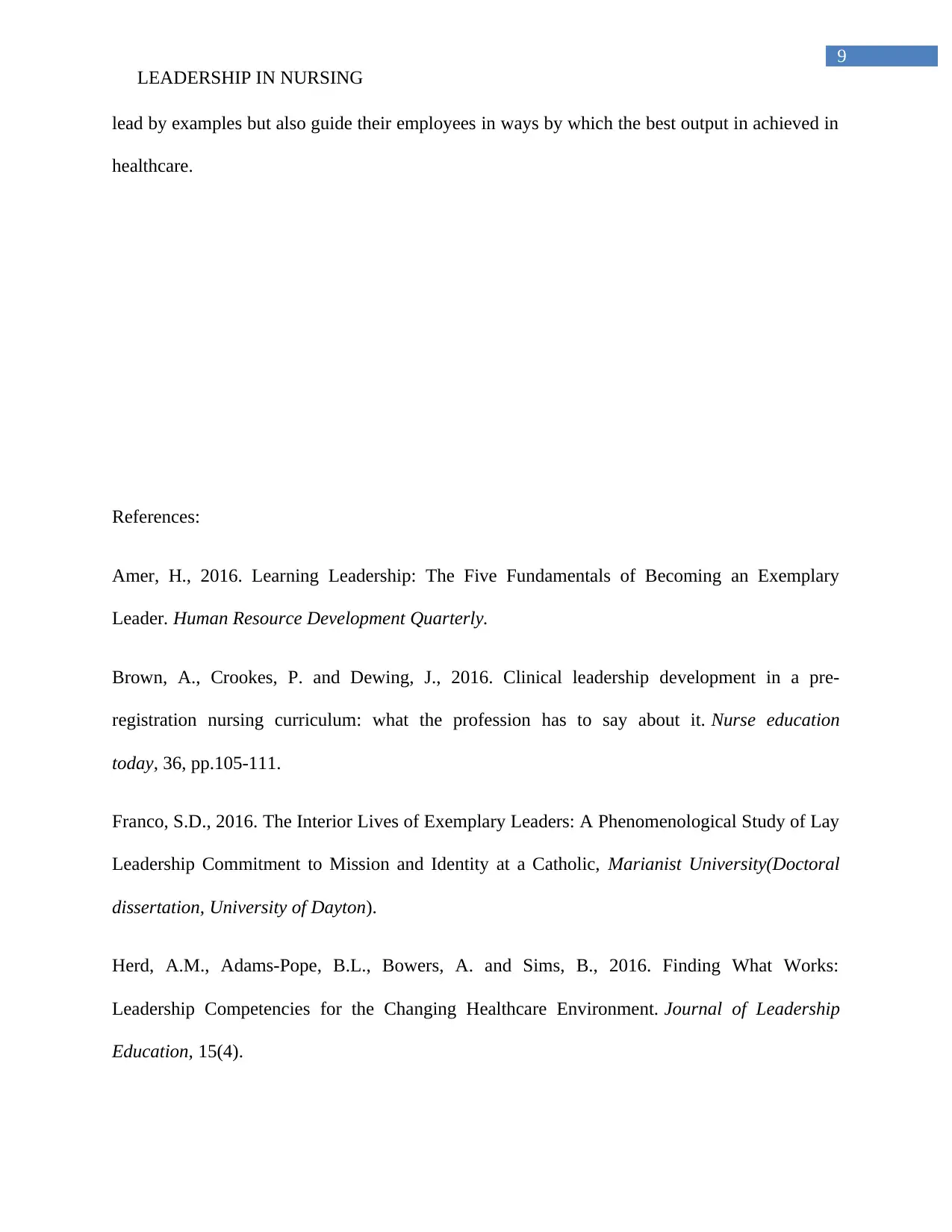
9
LEADERSHIP IN NURSING
lead by examples but also guide their employees in ways by which the best output in achieved in
healthcare.
References:
Amer, H., 2016. Learning Leadership: The Five Fundamentals of Becoming an Exemplary
Leader. Human Resource Development Quarterly.
Brown, A., Crookes, P. and Dewing, J., 2016. Clinical leadership development in a pre-
registration nursing curriculum: what the profession has to say about it. Nurse education
today, 36, pp.105-111.
Franco, S.D., 2016. The Interior Lives of Exemplary Leaders: A Phenomenological Study of Lay
Leadership Commitment to Mission and Identity at a Catholic, Marianist University(Doctoral
dissertation, University of Dayton).
Herd, A.M., Adams-Pope, B.L., Bowers, A. and Sims, B., 2016. Finding What Works:
Leadership Competencies for the Changing Healthcare Environment. Journal of Leadership
Education, 15(4).
LEADERSHIP IN NURSING
lead by examples but also guide their employees in ways by which the best output in achieved in
healthcare.
References:
Amer, H., 2016. Learning Leadership: The Five Fundamentals of Becoming an Exemplary
Leader. Human Resource Development Quarterly.
Brown, A., Crookes, P. and Dewing, J., 2016. Clinical leadership development in a pre-
registration nursing curriculum: what the profession has to say about it. Nurse education
today, 36, pp.105-111.
Franco, S.D., 2016. The Interior Lives of Exemplary Leaders: A Phenomenological Study of Lay
Leadership Commitment to Mission and Identity at a Catholic, Marianist University(Doctoral
dissertation, University of Dayton).
Herd, A.M., Adams-Pope, B.L., Bowers, A. and Sims, B., 2016. Finding What Works:
Leadership Competencies for the Changing Healthcare Environment. Journal of Leadership
Education, 15(4).
Secure Best Marks with AI Grader
Need help grading? Try our AI Grader for instant feedback on your assignments.
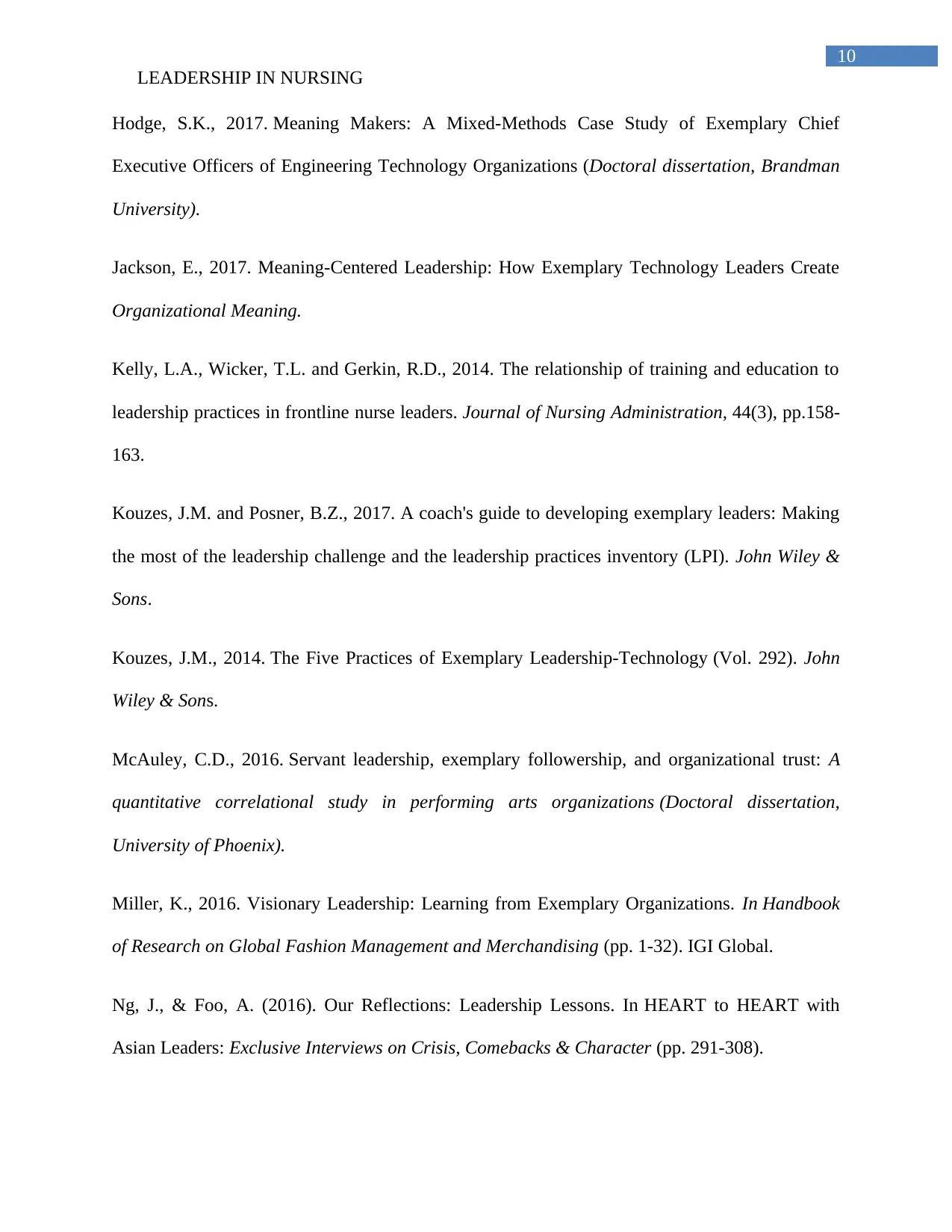
10
LEADERSHIP IN NURSING
Hodge, S.K., 2017. Meaning Makers: A Mixed-Methods Case Study of Exemplary Chief
Executive Officers of Engineering Technology Organizations (Doctoral dissertation, Brandman
University).
Jackson, E., 2017. Meaning-Centered Leadership: How Exemplary Technology Leaders Create
Organizational Meaning.
Kelly, L.A., Wicker, T.L. and Gerkin, R.D., 2014. The relationship of training and education to
leadership practices in frontline nurse leaders. Journal of Nursing Administration, 44(3), pp.158-
163.
Kouzes, J.M. and Posner, B.Z., 2017. A coach's guide to developing exemplary leaders: Making
the most of the leadership challenge and the leadership practices inventory (LPI). John Wiley &
Sons.
Kouzes, J.M., 2014. The Five Practices of Exemplary Leadership-Technology (Vol. 292). John
Wiley & Sons.
McAuley, C.D., 2016. Servant leadership, exemplary followership, and organizational trust: A
quantitative correlational study in performing arts organizations (Doctoral dissertation,
University of Phoenix).
Miller, K., 2016. Visionary Leadership: Learning from Exemplary Organizations. In Handbook
of Research on Global Fashion Management and Merchandising (pp. 1-32). IGI Global.
Ng, J., & Foo, A. (2016). Our Reflections: Leadership Lessons. In HEART to HEART with
Asian Leaders: Exclusive Interviews on Crisis, Comebacks & Character (pp. 291-308).
LEADERSHIP IN NURSING
Hodge, S.K., 2017. Meaning Makers: A Mixed-Methods Case Study of Exemplary Chief
Executive Officers of Engineering Technology Organizations (Doctoral dissertation, Brandman
University).
Jackson, E., 2017. Meaning-Centered Leadership: How Exemplary Technology Leaders Create
Organizational Meaning.
Kelly, L.A., Wicker, T.L. and Gerkin, R.D., 2014. The relationship of training and education to
leadership practices in frontline nurse leaders. Journal of Nursing Administration, 44(3), pp.158-
163.
Kouzes, J.M. and Posner, B.Z., 2017. A coach's guide to developing exemplary leaders: Making
the most of the leadership challenge and the leadership practices inventory (LPI). John Wiley &
Sons.
Kouzes, J.M., 2014. The Five Practices of Exemplary Leadership-Technology (Vol. 292). John
Wiley & Sons.
McAuley, C.D., 2016. Servant leadership, exemplary followership, and organizational trust: A
quantitative correlational study in performing arts organizations (Doctoral dissertation,
University of Phoenix).
Miller, K., 2016. Visionary Leadership: Learning from Exemplary Organizations. In Handbook
of Research on Global Fashion Management and Merchandising (pp. 1-32). IGI Global.
Ng, J., & Foo, A. (2016). Our Reflections: Leadership Lessons. In HEART to HEART with
Asian Leaders: Exclusive Interviews on Crisis, Comebacks & Character (pp. 291-308).
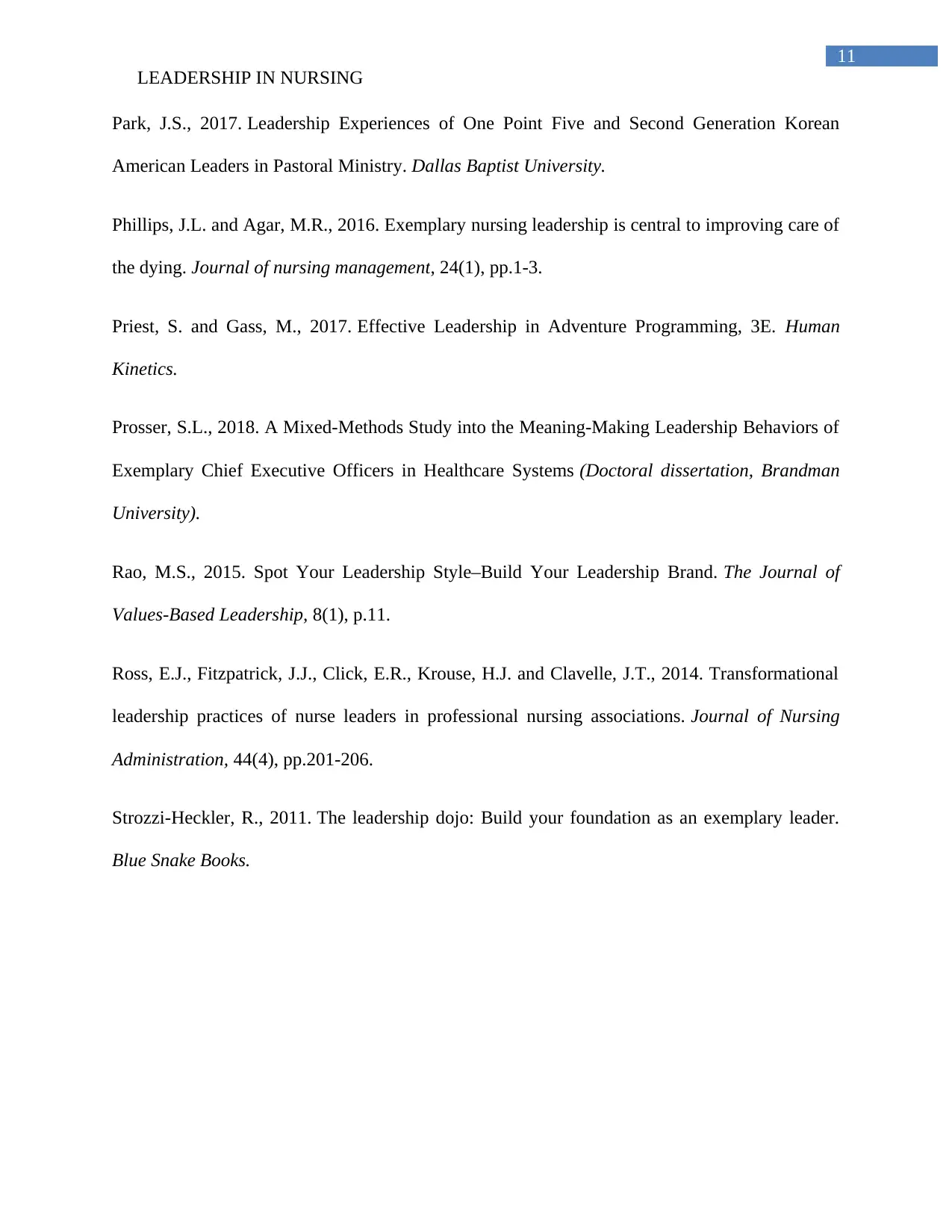
11
LEADERSHIP IN NURSING
Park, J.S., 2017. Leadership Experiences of One Point Five and Second Generation Korean
American Leaders in Pastoral Ministry. Dallas Baptist University.
Phillips, J.L. and Agar, M.R., 2016. Exemplary nursing leadership is central to improving care of
the dying. Journal of nursing management, 24(1), pp.1-3.
Priest, S. and Gass, M., 2017. Effective Leadership in Adventure Programming, 3E. Human
Kinetics.
Prosser, S.L., 2018. A Mixed-Methods Study into the Meaning-Making Leadership Behaviors of
Exemplary Chief Executive Officers in Healthcare Systems (Doctoral dissertation, Brandman
University).
Rao, M.S., 2015. Spot Your Leadership Style–Build Your Leadership Brand. The Journal of
Values-Based Leadership, 8(1), p.11.
Ross, E.J., Fitzpatrick, J.J., Click, E.R., Krouse, H.J. and Clavelle, J.T., 2014. Transformational
leadership practices of nurse leaders in professional nursing associations. Journal of Nursing
Administration, 44(4), pp.201-206.
Strozzi-Heckler, R., 2011. The leadership dojo: Build your foundation as an exemplary leader.
Blue Snake Books.
LEADERSHIP IN NURSING
Park, J.S., 2017. Leadership Experiences of One Point Five and Second Generation Korean
American Leaders in Pastoral Ministry. Dallas Baptist University.
Phillips, J.L. and Agar, M.R., 2016. Exemplary nursing leadership is central to improving care of
the dying. Journal of nursing management, 24(1), pp.1-3.
Priest, S. and Gass, M., 2017. Effective Leadership in Adventure Programming, 3E. Human
Kinetics.
Prosser, S.L., 2018. A Mixed-Methods Study into the Meaning-Making Leadership Behaviors of
Exemplary Chief Executive Officers in Healthcare Systems (Doctoral dissertation, Brandman
University).
Rao, M.S., 2015. Spot Your Leadership Style–Build Your Leadership Brand. The Journal of
Values-Based Leadership, 8(1), p.11.
Ross, E.J., Fitzpatrick, J.J., Click, E.R., Krouse, H.J. and Clavelle, J.T., 2014. Transformational
leadership practices of nurse leaders in professional nursing associations. Journal of Nursing
Administration, 44(4), pp.201-206.
Strozzi-Heckler, R., 2011. The leadership dojo: Build your foundation as an exemplary leader.
Blue Snake Books.
1 out of 12
Related Documents
Your All-in-One AI-Powered Toolkit for Academic Success.
+13062052269
info@desklib.com
Available 24*7 on WhatsApp / Email
![[object Object]](/_next/static/media/star-bottom.7253800d.svg)
Unlock your academic potential
© 2024 | Zucol Services PVT LTD | All rights reserved.





